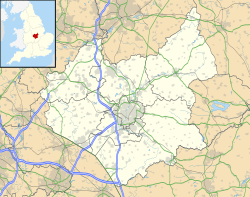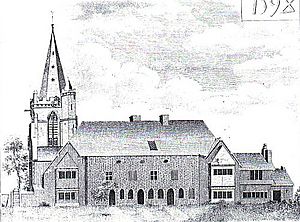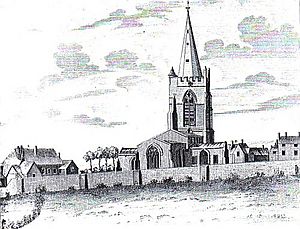Hinckley Priory facts for kids
| Monastery information | |
|---|---|
| Order | Benedictine |
| Established | before 1173 |
| Disestablished | c.1414 |
| Mother house | Lyre Abbey (Abbaye Notre-Dame de Lyre), La Vieille-Lyre, Normandy, France |
| Diocese | Diocese of Lincoln |
| Site | |
| Location | Hinckley, Leicestershire, England |
| Coordinates | 52°32′25″N 1°22′18″W / 52.540254°N 1.371627°W |
Hinckley Priory was a small, old monastery in Hinckley, Leicestershire, England. It was a place where monks lived and prayed many centuries ago.
The Story of Hinckley Priory
Hinckley Priory was a special kind of monastery called an 'alien priory'. This meant it was connected to a main monastery in another country. For Hinckley Priory, its main monastery was Lyre Abbey in France. We don't know the exact year it started, but it was before 1173.
The priory was quite small. In 1220, records show there were only two monks and the leader, called a prior. Even though it was small, the priory was important. Many of its priors acted as special representatives for Lyre Abbey in England and Wales.
Challenges During Wars
The wars between England and France in the 1400s caused problems for the priory. Because it was linked to a French monastery, it was in a difficult position.
In March 1399, Hinckley Priory was taken away from Lyre Abbey. Its control was given to the Carthusian monks of Mount Grace Priory in North Yorkshire. This was meant to last for the time the wars were happening.
A short peace with France meant the priory was returned in January 1400. But when fighting started again, things changed once more. In 1409, the money earned by Hinckley Priory was given to Queen Joan. She was the wife of King Henry IV. She received this money for the rest of her life.
The priory finally closed down around 1414. Its property was given to Mount Grace Priory again. Queen Joan also received a payment from the priory's funds.
What's Left Today?
In 1543, King Henry VIII gave the land that used to belong to the priory to Westminster Abbey. The old home of the prior was made bigger and turned into a house called "The Priory House". More parts were added to the house in the late 1500s. However, this house was pulled down in 1827.
People used to think the priory was located where the Parish Hall is now. But this wasn't certain. In 2004 and 2005, a local group dug test pits to find any hidden remains of the priory. They discovered parts of the priory to the south of the church that stands there today.
Not all of the priory has been dug up yet. In 2007, a report was published that described what had been found so far.




